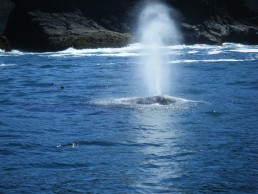Gray Whale Calves
Gray Whale Calves
The mouth of a newborn gray whale makes up about 90% of the length of its head and about 15% of the length of its entire body. When the calf grows up and is weaned it will get food by filtering large volumes of mud and water through baleen plates which are yellowish in color and hang from its upper jaw. The baleen acts like a large comb, catching tiny crustaceans in the hair-like fringe as water and mud are pushed out of the mouth. The young whale will use its tongue to lick the food off its baleen.
The skin of the gray whale feels like a peeled hardboiled egg, the skin easily stretches as the baby gains a layer of blubber to keep warm. The skin is dented or dimpled where hairs grow from those dents. The upper jaw has a few regularly spaced indents containing hair follicles; each indent has a coarse white hair about a half inch to an inch long. Whales are mammals, and mammals always have some hair.
When born, gray whales are a deep gray color with white to light gray patches. Newborns have whale lice, which are small crustaceans that live in the creases of their skin and feed on dead skin (this is beneficial for the whale). As the calf grows, its skin will also become embedded with barnacles, these barnacles and whale lice give older gray whales their mottled appearance. The skin of some baby whales has some scars, some scarring of the skin can happen when calves rub against the sandy bottom of the lagoons or rub against the barnacles on their mothers.
The calves nurse for about 6 months, the mother provides up to 50 gallons of milk each day, her milk contains 53% fat. Calves gain 60 to 70 pounds a day; this helps them build up blubber for their trip north. Mothers stay near their young to protect, and guide, babies have much to learn and they must gain strength. They spend most their time swimming alongside mom.
Interesting facts about Gray Whale Calves
Breeding and giving birth are the reason for southern migration.
Born without a blubber layer, babies need warmer waters.
Moms bear calves about every 2-3 years.
Gestation period averages 12 months (Sperm whale 17 months).
Pregnancy is telescopic; babies double their size the last 2 months.
Babies average 15 feet long at birth (Blue whale 26 feet).
Baby whales are born tail first.
Calves weigh about 2,000 pounds at birth (Blue whale 8,000 pounds).
Babies must surface and catch their first breath within 15 seconds.
Within 30 minutes, babies learn to swim.
Babies nurse frequently on rich milk, 50-60 percent fat.
Babies do not suck, the mother pumps milk into its mouth.
Calves put on as much as 9 pounds an hour.
Mothers lose 1/3 of their weight while nursing.

